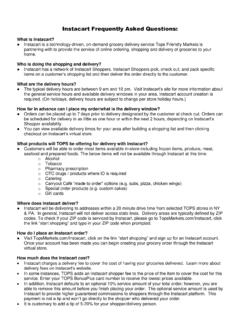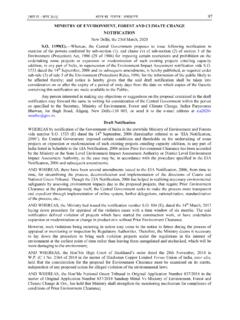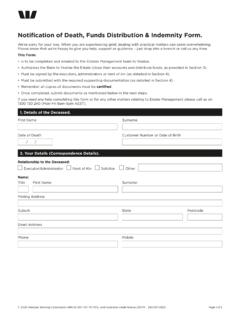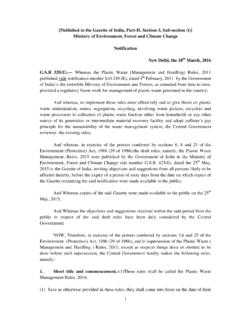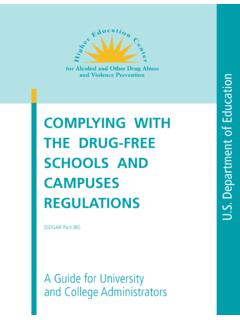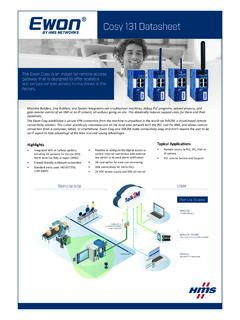Transcription of Q12 Step 5 Technical and regulatory considerations for ...
1 Official address Domenico Scarlattilaan 6 1083 HS Amsterdam The Netherlands An agency of the European Union Address for visits and deliveries Refer to Send us a question Go to Telephone +31 (0)88 781 6000 European Medicines Agency, 2020. Reproduction is authorised provided the source is acknowledged. 04 March 2020 EMA/CHMP/ICH/831751/2017 Committee for Medicinal Products for Human Use ICH guideline Q12 on Technical and regulatory considerations for pharmaceutical product lifecycle management - annexes Step 5 Transmission to CHMP 14 December 2017 Adoption by CHMP for release for consultation 14 December 2017 Start of consultation 14 December 2017 End of consultation (deadline for comments) 14 December 2018 Final adoption by CHMP 30 January 2020 Date for coming into effect* See below* *refer to the Note on EU implementation of ICH Q12 (EMA/CHMP/ICH/78332/2020) for further details.
2 ICH guideline Q12 on Technical and regulatory considerations for pharmaceutical product lifecycle management - annexes EMA/CHMP/ICH/831751/2017 Page 2/28 Q12 Document History Code History Date Q12 Adopted by the regulatory Members of the ICH Assembly under Step 4 (document dated 19 November 2019). 20 November 2019 Q12 Endorsement by the Members of the ICH Assembly under Step 2 and release for public consultation (document dated 31 October 2017). 16 November 2017 ICH guideline Q12 on Technical and regulatory considerations for pharmaceutical product lifecycle management EMA/CHMP/ICH/831751/2017 Page 3/28 ICH guideline Q12 on Technical and regulatory considerations for pharmaceutical product lifecycle management Table of contents Annex I: Illustrative Examples.
3 4 Annex IA: Identification of Established Conditions for the manufacturing process - chemical medicinal product .. 5 Annex IB: Identification of Established Conditions for the manufacturing process - biological medicinal product .. 10 Annex IC: Identification of Established Conditions for analytical procedures .. 17 Annex ID: PACMP example 1 .. 20 Annex IE: PACMP example 2 .. 22 Annex IF: product Lifecycle Management Document - Illustrative Example .. 22 Annex II: Structured Approach to Analytical Procedure Changes .. 26 ICH guideline Q12 on Technical and regulatory considerations for pharmaceutical product lifecycle management EMA/CHMP/ICH/831751/2017 Page 4/28 Annex I: Illustrative examples The examples provided in Annex IA through IF are mock examples provided for illustrative purposes.
4 They only suggest how the tools described in chapters 3, 4, and 5 could be applied, and should not be used as a template or the sole basis for a regulatory submission. In addition, the reporting categories, as described in Chapter 2, may differ across regions depending on regional legislation, the nature of the product , and the MAH s demonstrated understanding of the product , process, and analytical procedure. Terminology used in examples: ICH Terminology Regional Terminology Prior Approval (PA) PAS, Type II, PCA, etc. notification Moderate (NM) CBE 30, Type IB, MCN, etc. notification Low (NL) CBE 0, AR, Type IA, MCN, etc. Not Reported (NR) Annex IA and IB: Identification of Established Conditions for the Manufacturing Process The examples in 1A and 1B illustrate how the development approaches described in Chapter 3, section of the ICH Q12 Guideline could be applied.
5 The examples describe different development approaches and resulting control strategies to illustrate how they influence the identification of ECs and reporting categories. MAAs could consist of a combination of these approaches. These examples demonstrate that increased knowledge and understanding gained from progressively more extensive development approaches lead to reduction of uncertainty and improved management of risk. As a result, ECs could become less extensive and reporting categories more flexible. For example: Enhanced knowledge may lead to a reduction in uncertainty, demonstrating that a material attribute or process parameter initially considered potentially critical in a minimal approach is not actually critical, , does not have an impact on product quality and, therefore, is not an EC.
6 Risk management activities could lead to different reporting categories , a change from prior approval to a notification for a change to a CPP. Where the performance-based approach is used, some process parameters may not be classified as ECs due to assurance of quality being provided by online monitoring. In this circumstance, the typical operating conditions for process parameters are provided as supportive information. During manufacture, the process parameters may be adjusted to deliver the expected outcome. The risks related to the in-line PAT (Process Analytical Technology) tests, , NIR, should be appropriately managed throughout the lifecycle. In-line PAT tests used for quality control are considered ECs.
7 A holistic view of the manufacturing process and overall control strategy is necessary when considering ECs since the output of one unit operation is the input for a subsequent operation ICH guideline Q12 on Technical and regulatory considerations for pharmaceutical product lifecycle management EMA/CHMP/ICH/831751/2017 Page 5/28 Annex IA: Identification of Established Conditions for the manufacturing process - chemical medicinal product Powder Blending Unit Operation Parameter Acceptable ranges and reporting categories (White boxes are ECs and grey boxes are not ECs.) Minimal Parameter-Based Approach Enhanced Parameter-Based Approach Performance-Based Approach Input Materials API PSD 20-50 um Tighten (NL) Widen (PA) 5-200 um Tighten (NL) Widen (NM) 5-200 um Tighten (NL) Widen (NM) API Moisture < (NM) (NR) (NR) Excipients #1-3 Specification Pharmacopoeial Pharmacopoeial Pharmacopoeial Equipment and Parameters Operating Principle Diffusion Mixing (PA) Diffusion Mixing (PA) Diffusion Mixing (PA) Equipment type V-blender (NM) V-blender (NL) (NR) Scale 200 kg Increase >10x (NM) 200 kg Increase >10x (NL) 200-600 kg Increase >10x (NL) Blend Speed 20 rpm CPP (NM) Design Space consisting of Blend speed.
8 10-20 rpm Blend time 15-25 minutes CPP (NM) 15 rpm CPP (NR) Blend Time 20 minutes CPP (NM) 20 minutes CPP (NR) ICH guideline Q12 on Technical and regulatory considerations for pharmaceutical product lifecycle management EMA/CHMP/ICH/831751/2017 Page 6/28 Output Performance Measure Homogeneity method principle HPLC (NM) Not Tested NIR online analyser (PA) Homogeneity acceptance criteria <5% RSD IPC (NM) Not Tested <5% RSD IPC (NM) Parameter Acceptable ranges and reporting categories (White boxes are ECs and grey boxes are not ECs.) Minimal Parameter-Based Approach Enhanced Parameter-Based Approach Performance-Based Approach ICH guideline Q12 on Technical and regulatory considerations for pharmaceutical product lifecycle management EMA/CHMP/ICH/831751/2017 Page 7/28 Comments / Justification For this example, discussion and justification for selected parameters are provided to illustrate concepts in chapter EC refers to the identification of ECs; reporting refers to the assessment of appropriate reporting category.
9 Excipient specifications are ECs and managed in line with the Pharmacopoeia. Equipment operating principle is an EC in all cases. Minimal Parameter-Based Approach API PSD EC: The impact of particle size distribution (PSD) of API on blend homogeneity and dissolution could not be excluded during development. PSD was not studied outside the range of 20-50 um; this range is an EC. Reporting: The impact of a change outside this range on blend homogeneity and dissolution is unknown, and the risk to product quality is potentially high. As a result, any future change outside the range would be reported as PA, supported by appropriate studies and data. Changes to tighten the EC range based on knowledge gained during the commercial phase ( , better process control observed at tighter ranges) are considered low risk and reported as NL.
10 API Moisture EC: The impact of API moisture content on blend flowability, which impacts content uniformity, could not be reasonably excluded during development and has not been further studied in detail. The set point value is based on a limited amount of development and manufacturing data. API moisture content is therefore considered an EC. Reporting: A change in this EC is considered moderate risk since downstream processing involves a power-assisted feeder in the tablet press which mitigates the risk of content uniformity failure. The change is reported as NM. Blend Equipment: EC: Only one type of blending equipment (V-blender) was considered in development.











